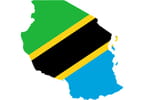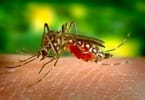A gentle voice outside the tent-flap murmurs: ‘Morning, morning.’ During the night, hyenas whooped and howled persistently, so close behind the camp that their mournful wails seemed to rattle the guy ropes and, from time to time, lions roared. But now, just before dawn, absolute silence reigns.
Trunk enthrall: Elephants and buffalo cross the Luangwa River in Zambia
Hot water has arrived in each washing bowl. Breakfast is ready on the riverbank: tea, coffee, porridge and toast, cooked over a fire of mopane wood, which gives the food a special tang. We eat quickly, on our feet, watching the eastern sky start to glow, until a huge ball of fiery crimson climbs over the horizon and sets the surface of the river alight.
By 6.15am we are on our way. ‘Keep behind me in single file,’ says our leader, Robin Pope. ‘If anything starts to happen, stay bunched together. Don’t run.’
Out front is our escort scout, Piela Nandila, armed with a loaded .375 rifle. Next comes Robin, then the six of us, and at the back our tea-carrier Jonathan Mbao, swinging a fearsome machete.
The terrain is mostly flat, and now, in the dry winter season, the predominant colours of the bush are buff and reddish brown, with fine trees – African ebony, breonadia, pod mahogany – rising above the scrub.
We’re crawling like ants across one far corner of the South Luangwa National Park, which covers 9,050 square kilometres, or about 2.25 million acres – more than twice the size of Gloucestershire. Here, Robin has secured the sole camping concession, so apart from our own followers and the odd ranger patrol, there are no other people or vehicles.
Robin has an impressive track record. He began working as a safari guide in 1976 for Norman Carr, the celebrated pioneer of conservation, and he has lived in South Luangwa ever since.
In 1999 he and his wife Jo completely refurbished their third camp at Nsefu, and today they take a leading part in Zambian tourism and conservation activities.
No question that he is a guide in a million. Not only is his knowledge of the bush encyclopaedic: he has unquenchable enthusiasm for sharing it.
‘Look!’ he says, pointing. ‘Red-billed hoopoes going through those trees. There’s a grey lourie, known as the go-away bird, from its call. And watch that roller – I think it’s going to perform.’
Sure enough, a lilac-breasted bird the size of a pigeon is circling ever higher until suddenly it spins over and hurtles down vertically in a stupendous display dive.
In the early morning cool, the animals are on the move – elegant impala, with black stripes down their backsides, and the chunkier, chestnut-coloured puku.
Troops of baboons are foraging for their breakfast. Zebras move off snorting the moment they spot us. By mid-morning, the sun is seriously hot, and everyone is glad to stop for tea, expertly made by Jonathan with scalding water from the flasks in his rucksack.
As we lounge beside a lagoon bright green with its covering of Nile cabbage, Robin tells how he once came upon the back end of a python protruding from a hole in the ground.
Most people would have left it well alone, but when curiosity impelled him to grip it, he realised the snake was dead and pulled it out to find that it was 14 feet long and contained 68 eggs.
Call of nature: Robin Pope has played a leading role in Zambian tourism and conservation activities.
Tracks in the bed of a sand river show that elephants crossed in the night, and Robin points out the intricate pattern of veins on the soles of their feet, as individually distinctive as human fingerprints.
Large and small, brilliantly plumaged and infinitely varied, the birds are thrilling. Bataleur eagles soar above, their tails so short they can look as if flying backwards.
Marabou storks and ground hornbills pace beside the lagoons. Flocks of tiny red-billed queleas – sparrow-sized but twice as speedy – fizz about in formations.
Most fascinating is the greater honeyguide, which leads honeyhunters to their quarry in the hope that they will cut open a tree in which bees have nested and leave some of the spoils for their pilot.
A small, buff-coloured bird, it solicits our attention with chittering calls and flies ahead from tree to tree, leading us on. Robin assures me that, if we followed it, we’d find a swarm – but also that if we failed to leave a share of the honey, the vengeful bird would lead us, next time, to a snake or crocodile.
By 1.15pm, after seven hours on the march, we’re hot and hungry – but then, a miracle.
There in a grove, is our camp, which has been dismantled, ferried seven or eight miles and resurrected on a new site beside the river.
Here are our twin-bedded, wellnetted tents set out in a neat line, and two little loo-tents – ladies’ to the left, gents’ to the right – and the shower cubicle. The bar and gas-powered fridgefreezer are installed at the base of a tree. The table, set for lunch, stands in a clearing.
Michelle Atala, the camp manager, greets us with chilled, damp face-cloths and glasses of cold beer. Minutes later we sit down to a sumptuous meal.
It seems barely possible that the chef has cooked it in his earth oven – a mere pit in the ground. But he’s a culinary magician, and from this square-sided hole he produces delicious bread, brown and white, scones, muffins and cakes to die for.
After a siesta, we walk again. Before dark falls swiftly at 5.40pm, we drink sundowners at a fine vantage point. Then, back in camp, we shower and eat alfresco supper.
Standing at the edge of the lamplight, one of the staff announces the menu with beautiful enunciation: ‘First course is spinach and feta filo parcels. Main course is tilapia fish baked with onions in white wine, with brown rice, steamed broccoli and carrot batons in honey. Sweet is apple crumble and hot custard. Wines are Zonnebloem Chardonnay and Bellingham Cabernet Sauvignon. Enjoy your dinner!’
One evening as we walked along the River Piela, we spotted the fresh leopard track. Ahead, from a grove of big trees, came a sudden cacophonous eruption of barks, screams and whistles, as antelopes and monkeys shot into view.
Clearly there’d been a kill; soon we found it: a pregnant female impala dead next to a tree, neck punctured by deep tooth marks.
Robin’s ceaseless flow of anecdote, local superstition and botanical information made every walk enthralling. He told us eland bulls on the move communicate via clicking sounds from their knees and that dung beetles find elephant droppings with the sensors in their wings
Every day, we saw glorious new birds, and clocked more than 130 species (out of a possible 480), among them a Mozambique nightjar, so perfectly camouflaged we could scarcely make it out only seven or eight yards away.
Our mobile safari left ineradicable memories. None of us will ever forget sundowners on a hill in the great grasslands of the Lundu Plain. Elephants were grazing on three sides.
All around lay lumps of –petrified wood, 150 million years old. We had a 360-degree command of the horizon, and in that vast expanse, as night fell, there was not a single light or sign of human habitation.
Read more: http://www.dailymail.co.uk/travel/article-1213066/Zambia-safaris-Elephants-baboons-walk-wild-stunning-South-Luangwa.html?ITO=1490#ixzz0RXWEPIQd
WHAT TO TAKE AWAY FROM THIS ARTICLE:
- Tracks in the bed of a sand river show that elephants crossed in the night, and Robin points out the intricate pattern of veins on the soles of their feet, as individually distinctive as human fingerprints.
- As we lounge beside a lagoon bright green with its covering of Nile cabbage, Robin tells how he once came upon the back end of a python protruding from a hole in the ground.
- Most fascinating is the greater honeyguide, which leads honeyhunters to their quarry in the hope that they will cut open a tree in which bees have nested and leave some of the spoils for their….






















